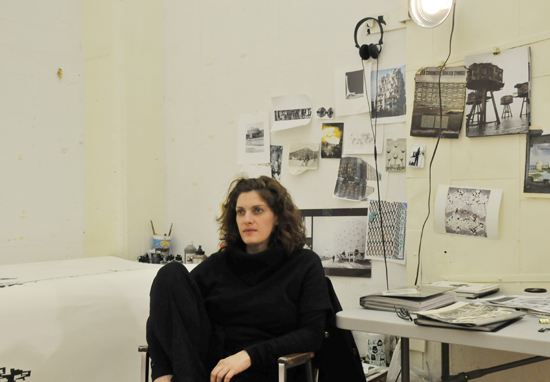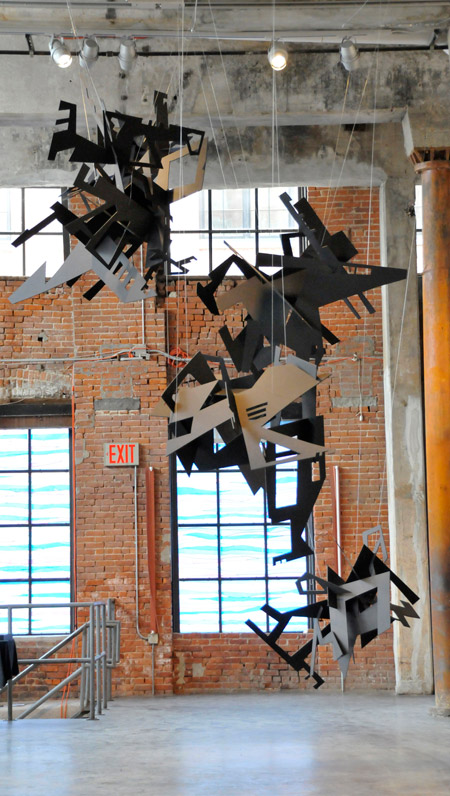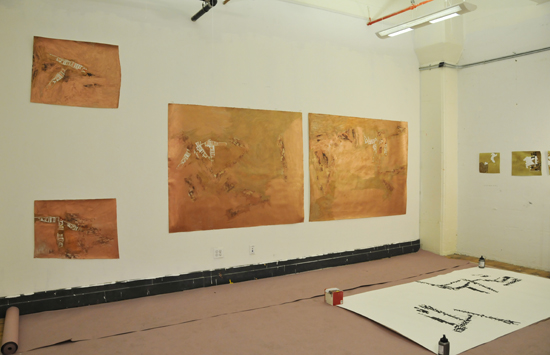
Caitlin Masley at her studio in DUMBO. (Image: Carissa Pelleteri)
Looking at Baltimore’s busted-out vacancies last weekend, with their broken, boarded-up windows and exhausted dereliction, I couldn’t help but think of a phrase the artist Caitlin Masley used when we spoke in January: “monuments to failure.” It’s an interesting description, because monuments tend to valorize failure’s opposite: success and the heroic triumphs of civilization. Beyond recognizing fallen soldiers and epic battles, monuments reserve their monumentality for the great and the good. Yet so much of life is neither great nor good, and if reality is to be preserved in statuary, isn’t it equally worth capturing the sad defeats of life? And if we were to pursue that idea, would we need to go much farther than the half-built developments littering so much of America today? Aren’t their shells evidence of stock market failure and an inability to curb our greed for more land, more profit?
Those are the kinds of questions Masley’s artworks prompt. Her sculptures, drawings, installations, and photography speak to the hoped-for futures humans conjure and then leave behind, whether in their imaginations or here in the material world. There is, for instance, “TWOTOWERSVER2,” a manipulated photo of an imaginary landscape in postwar reconstruction, and “Copperland,” a series of abstract drawings overlaid in copper leafing. In the works, dense clusters of human habitation are seen from a bird’s-eye view, with some sections darkened as if erased, the whole of it suggesting a desert landscape—El Paso at night maybe, or, more likely, bombed villages in the Middle East.

"Neo Habitat" at Smack Mellon, January 2011. Image courtesy of the artist.
We discussed her work, which was part of a group show at Smack Mellon a few months ago. In the interlude, Masley had her second child and began preparing for the upcoming group show “Blind Faith” at NP Contemporary Art Center. Me, I worked very hard on multiple jobs and thought I would die, yet it’s doubtful my efforts were as productive as that of the prolific and talented Masley. Below is our talk.
What is it about space and place that captivates you?
I have to be a little cheesy and say it comes from my childhood. I grew up in Columbia, Maryland, which was an experimental town. I didn’t realize what kind of place it was until I went to West Virginia to go to college. After being in Morgantown a couple of months, I was, like, Oh my god, this place is so ugly. I don’t want to be here. Then I was, like, what is my problem? It made me start thinking about the kind of place I come from—where your lawn is mowed all the time and there are all these architectural guidelines. I didn’t realize everything was visually organized, so I started examining the way facades represent what’s inside them, different buildings on campus, the way things were organized. My final project was a variety of prints and paintings that addressed landscapes in an abstracted way and how one represents beauty and decay.
When I went to graduate school, I started doing a lot of work on metaphors for utopias and how there’s a direct conflict between human nature and utopic realities of—
You think there are utopic realities?
There are good tries. The realities are short-lived because human nature doesn’t allow for that. We’re not meant to live in one sort of situation for a long time. Humans are builders, and we don’t build things that have a lot of forethought and that will last over time and adapt.

New work at the artist's studio. (Image: Carissa Pelleteri)
You’re talking about futility and the ways that planning doesn’t happen. How does that relate to what you’ve got up in the studio—the bird’s eye view of cities and the space around them that they show?
These are really new works. I just did them in the last couple of months. I went in my practice from documenting and examining utopias in different ways from where I grew up, and then moved from the personal to the public, to the global from the personal. A real stopping point that led to the work I’m doing now is that I started traveling to Berlin after 9/11.
New York is quite a labyrinth. Something’s always changing. When I went to Berlin, there was history and political history in almost every building. I started realizing that America’s so young and what architecture can contain, not just personal stories or a function, but geo/socio/political issues, an era you’re reminded of every day you walk by it. That really struck me, so I started examining buildings internationally that affect the way we live and how navigate or build around, what we tear down.
When we invaded Iraq, I decided I needed to go home for a little bit because I wasn’t sure what would happen, so I started listening to the radio and making drawings from housing projects that I did in Baghdad.
You traveled to Baghdad?
I have a friend who did, who’s a photojournalist. He let me go through all his photos, and I started thinking about reconstruction [in Iraq]. I was, like, you can’t reconstruct where there’s nothing there. So I started doing drawings to let me fantasize about what I wasn’t seeing, like how to depict borders and movement, men in action, people traveling or gunfights or whatever. It’s hard because I have no real cultural connection to these places. It’s sort of a weird thing to be saying.
No, it’s not. I think it’s healthy to consider what could be. People spend a lot of time looking at what is and making comments on that, which is fine, but I think imagination is good. Still, do you think it’d be useful for you to travel to these places?
I travel a lot. I’ve been to a lot of different places, and I like traveling. My husband is French-Swiss, and we spend a fair amount of time in Europe. The borders in France, Switzerland, and Germany—there’s never anyone there. There’s a couple of big border posts but then they have these little boxes on a dirt road practically, and no one’s ever there. In fact, when we went into Switzerland from Germany, there was no one there to stamp our passport. When I went to Tel Aviv for a show a month later, they were like, “How did you get from x to wherever?” And I was, like, “There was nobody home!”
How does that affect your sense of boundaries and borders? In Europe, the idea of borders and boundaries is not an actual idea, but an actual experience, as you just described.
It’s a lot more vague in the States than in Europe, where people say, “You cannot come here.” That just blows my mind. How can you own a piece of the earth? Man creates legacy and populations to inhabit that space—that patch of dirt—to claim it forever. I can’t say I like or dislike it, but I think it’s fascinating.
Why does the idea of abandoned legacy speak to you?
I think it’s kind of amazing that people keep trying. Our memories are very short, especially in the States, whereas in other cities, they have buildings that are, like, still riddled by bullets, like in Berlin. You can’t forget, though you’re growing up and have no real connection to it. But what I’ve observed going over there the last couple of years is that, as the years pass, it’s like a folk story to kids, especially with the internet. There’s nothing that deals with borders and physical boundaries. It’s very hard for people to hold onto histories that other people hold onto. We build for our actual lifespan and then things change, whether it’s from the outside or the inside. Nature—tornados, hurricanes—will change a place, or there’s a manmade force that wreaks destruction. There are housing projects that have been started, and then people have to leave because of some political treaty—because some people in a room said you have to leave. There are these huge structures littered all over the world in different places and different countries for different reasons. They’re just sitting there. It’s like monuments to failure or a missed future.
ARTIST WEBSITE:
caitlinmasley.com

 RSS
RSS
